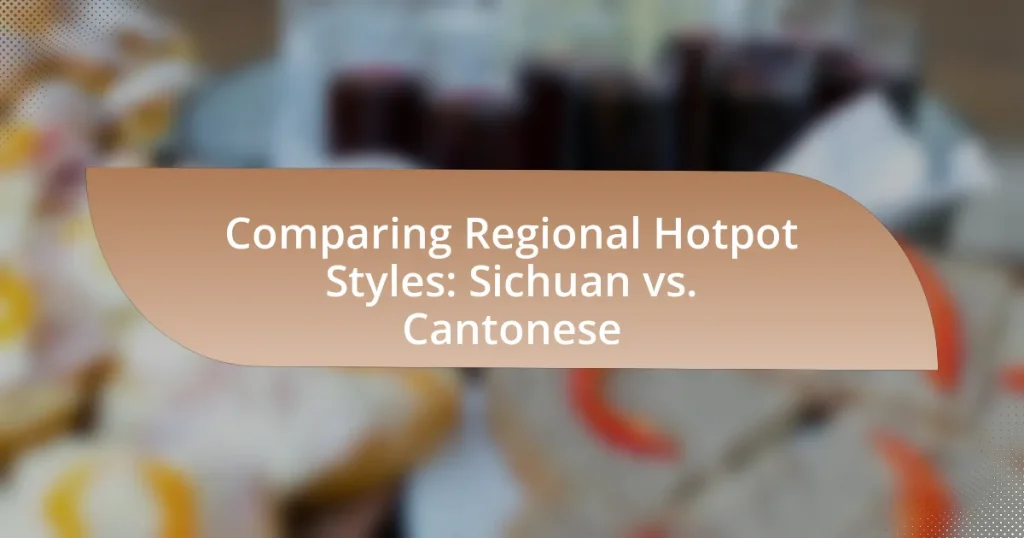The article compares the distinct hotpot styles of Sichuan and Cantonese cuisine, highlighting their key differences in flavor profiles, ingredients, and cooking methods. Sichuan hotpot is characterized by bold, spicy flavors, often featuring Sichuan peppercorns and a variety of meats and vegetables cooked in a spicy broth. In contrast, Cantonese hotpot emphasizes a lighter, more delicate taste with a focus on fresh seafood and high-quality meats in a clear broth. The article also explores the cultural influences, dining experiences, and ingredient selections that shape each hotpot style, providing a comprehensive overview of their unique culinary traditions.

What are the key differences between Sichuan and Cantonese hotpot styles?
Sichuan and Cantonese hotpot styles differ primarily in flavor profiles and ingredients. Sichuan hotpot is characterized by its bold, spicy flavors, often featuring a numbing heat from Sichuan peppercorns and a variety of chili oils, while Cantonese hotpot emphasizes a lighter, more subtle taste, focusing on fresh ingredients and clear broth. Sichuan hotpot typically includes a wider range of meats and vegetables, often cooked in a spicy broth, whereas Cantonese hotpot often uses a clear broth with an emphasis on seafood and high-quality meats, allowing the natural flavors to shine. These distinctions reflect the broader culinary traditions of their respective regions, with Sichuan cuisine known for its intense flavors and Cantonese cuisine celebrated for its freshness and balance.
How do the flavor profiles of Sichuan and Cantonese hotpot differ?
Sichuan hotpot features bold, spicy, and numbing flavors primarily due to the use of Sichuan peppercorns, chili oil, and a variety of spices, creating a complex and intense taste experience. In contrast, Cantonese hotpot emphasizes a lighter, more delicate flavor profile, focusing on fresh ingredients and subtle seasonings like ginger and scallions, allowing the natural flavors of the ingredients to shine through. This distinction is rooted in regional culinary traditions, where Sichuan cuisine is known for its heat and complexity, while Cantonese cuisine prioritizes freshness and simplicity.
What ingredients contribute to the unique flavors of Sichuan hotpot?
Sichuan hotpot’s unique flavors are primarily contributed by Sichuan peppercorns, chili peppers, garlic, and a variety of meats and vegetables. Sichuan peppercorns provide a distinctive numbing sensation, while chili peppers add heat and depth. Garlic enhances the overall flavor profile, and the selection of fresh meats, such as beef and lamb, along with vegetables like mushrooms and leafy greens, further enriches the dish. The combination of these ingredients creates a complex and bold taste that is characteristic of Sichuan cuisine.
What ingredients are essential for Cantonese hotpot flavor?
Essential ingredients for Cantonese hotpot flavor include a clear broth, fresh seafood, thinly sliced meats, and a variety of vegetables. The clear broth, often made from chicken or pork bones, serves as the base that enhances the natural flavors of the ingredients. Fresh seafood such as shrimp, fish, and scallops are commonly used for their delicate taste. Thinly sliced meats, typically beef or lamb, cook quickly and absorb the broth’s flavor. A selection of vegetables like mushrooms, leafy greens, and tofu adds texture and nutritional value. These components collectively create the mild yet flavorful profile characteristic of Cantonese hotpot, distinguishing it from the spicier Sichuan style.
What cooking methods are used in Sichuan and Cantonese hotpot?
Sichuan and Cantonese hotpot utilize different cooking methods that reflect their regional flavors. Sichuan hotpot primarily employs a boiling method where ingredients are cooked in a spicy, aromatic broth, often infused with Sichuan peppercorns and chili oil, creating a numbing and spicy experience. In contrast, Cantonese hotpot typically uses a lighter broth, often made from seafood or chicken, and emphasizes a simmering method, allowing for a more delicate flavor profile. This distinction in cooking methods highlights the unique culinary traditions of each region, with Sichuan focusing on bold, intense flavors and Cantonese favoring subtlety and freshness.
How does the cooking process in Sichuan hotpot enhance its flavors?
The cooking process in Sichuan hotpot enhances its flavors through the use of a spicy, aromatic broth that infuses ingredients with depth and complexity. The broth typically contains a variety of spices, including Sichuan peppercorns, which provide a unique numbing sensation, and chili peppers, which contribute heat. As ingredients are cooked in this flavorful broth, they absorb the spices and oils, resulting in a rich, layered taste profile. Additionally, the communal cooking style allows for a dynamic interaction between the ingredients and the broth, further intensifying the overall flavor experience.
What techniques are characteristic of Cantonese hotpot preparation?
Cantonese hotpot preparation is characterized by techniques such as using a clear broth base, a variety of fresh ingredients, and a focus on individual dipping sauces. The clear broth, often made from simmered chicken or seafood, serves as a light and flavorful foundation. Fresh ingredients, including thinly sliced meats, seafood, and an assortment of vegetables, are prepared for quick cooking in the broth. Additionally, diners typically create personalized dipping sauces from ingredients like soy sauce, sesame oil, and garlic, enhancing the overall flavor experience. These techniques emphasize freshness and customization, distinguishing Cantonese hotpot from other regional styles.
What cultural influences shape Sichuan and Cantonese hotpot styles?
Sichuan and Cantonese hotpot styles are shaped by distinct cultural influences rooted in their respective regional histories and culinary traditions. Sichuan hotpot is heavily influenced by the region’s agricultural practices, which emphasize bold flavors and the use of spices, particularly Sichuan peppercorns, reflecting the local preference for spicy and numbing tastes. In contrast, Cantonese hotpot is influenced by the coastal geography of Guangdong province, leading to a focus on fresh seafood and lighter, more delicate flavors, showcasing the Cantonese culinary philosophy of freshness and balance. These cultural influences are evident in the ingredients, cooking methods, and flavor profiles that define each hotpot style.
How does regional history affect Sichuan hotpot traditions?
Regional history significantly influences Sichuan hotpot traditions by shaping its unique flavor profiles and cooking methods. The Sichuan region, known for its spicy climate and agricultural practices, has historically favored the use of bold spices like Sichuan peppercorns and chili peppers, which are integral to hotpot dishes. This preference stems from the region’s historical trade routes that facilitated the introduction of diverse ingredients and culinary techniques, allowing for the development of a distinctive hotpot style characterized by its intense heat and complex flavors. Additionally, the cultural significance of communal dining in Sichuan, rooted in local customs and social practices, has further solidified hotpot as a central culinary tradition, reflecting the region’s historical emphasis on family and community gatherings.
What cultural elements are reflected in Cantonese hotpot dining experiences?
Cantonese hotpot dining experiences reflect cultural elements such as communal dining, emphasis on fresh ingredients, and the importance of social interaction. The communal aspect is evident as diners gather around a shared pot, fostering a sense of togetherness and collaboration. Fresh ingredients are prioritized, showcasing Cantonese culinary values that emphasize quality and seasonal produce. Additionally, the practice of customizing individual dipping sauces highlights personal preferences and creativity, further enhancing the social experience. These elements collectively illustrate the Cantonese approach to food as a means of building relationships and celebrating community.

What are the popular ingredients used in Sichuan and Cantonese hotpot?
Sichuan hotpot commonly features spicy broth, various meats such as beef and lamb, tofu, and a wide array of vegetables like mushrooms and leafy greens. In contrast, Cantonese hotpot emphasizes a lighter broth, often seafood, thinly sliced meats, and fresh vegetables, including bok choy and Chinese cabbage. The distinct flavor profiles of Sichuan hotpot are characterized by the use of Sichuan peppercorns and chili oil, while Cantonese hotpot focuses on the freshness of ingredients and a more subtle seasoning approach.
What types of proteins are commonly found in Sichuan hotpot?
Sichuan hotpot commonly features a variety of proteins, including beef, lamb, pork, chicken, and seafood. These proteins are often sliced thinly to facilitate quick cooking in the spicy broth. Beef and lamb are particularly popular due to their rich flavors, while seafood options like shrimp and fish add a different texture and taste. The inclusion of these proteins is essential to the overall experience of Sichuan hotpot, which emphasizes bold flavors and a diverse range of ingredients.
Which seafood options are popular in Sichuan hotpot?
Popular seafood options in Sichuan hotpot include shrimp, fish fillets, squid, and clams. These seafood choices are favored for their ability to absorb the spicy and flavorful broth characteristic of Sichuan cuisine. The inclusion of these ingredients enhances the overall dining experience, as they complement the bold flavors of the hotpot.
What meats are typically used in Sichuan hotpot dishes?
Sichuan hotpot dishes typically use a variety of meats, including beef, lamb, and pork. Beef is often sliced thinly and can include cuts like ribeye or brisket, while lamb is commonly used for its rich flavor. Pork, particularly belly or shoulder, is also a popular choice. These meats are chosen for their ability to absorb the bold and spicy flavors characteristic of Sichuan cuisine, enhancing the overall dining experience.
What vegetables and sides are essential for Cantonese hotpot?
Essential vegetables and sides for Cantonese hotpot include napa cabbage, bok choy, mushrooms, and tofu. Napa cabbage provides a crunchy texture and absorbs flavors well, while bok choy adds a mild sweetness. Mushrooms, such as shiitake and enoki, contribute umami and depth to the broth. Tofu serves as a protein-rich option that complements the vegetables. These ingredients are commonly used in Cantonese hotpot due to their ability to enhance the overall taste and experience of the dish.
Which leafy greens are favored in Cantonese hotpot?
Cantonese hotpot typically favors leafy greens such as Chinese cabbage, spinach, and watercress. These greens are chosen for their ability to absorb flavors and their quick cooking time, making them ideal for the hotpot experience. Chinese cabbage, for instance, is commonly used due to its tender texture and mild taste, which complements the rich broth. Spinach is favored for its nutritional value and vibrant color, while watercress adds a peppery flavor that enhances the overall dish.
What dipping sauces complement Cantonese hotpot?
Dipping sauces that complement Cantonese hotpot include sesame sauce, soy sauce, and garlic sauce. Sesame sauce, made from ground sesame seeds, provides a rich and nutty flavor that enhances the taste of the ingredients cooked in the hotpot. Soy sauce adds a salty and umami element, while garlic sauce introduces a pungent kick, balancing the overall flavor profile. These sauces are commonly used in Cantonese hotpot dining, reflecting traditional preferences and enhancing the dining experience.
How do the ingredient choices reflect the regional preferences?
Ingredient choices in Sichuan and Cantonese hotpot reflect distinct regional preferences, with Sichuan favoring bold, spicy flavors and Cantonese emphasizing fresh, subtle tastes. Sichuan hotpot typically includes ingredients like spicy chili oil, Sichuan peppercorns, and a variety of meats and vegetables that enhance the heat and complexity of the dish, aligning with the region’s culinary tradition of bold flavors. In contrast, Cantonese hotpot features lighter broths and fresh seafood, such as fish and shellfish, along with seasonal vegetables, showcasing the region’s focus on freshness and natural flavors. This difference in ingredient selection illustrates how local agricultural products and cultural tastes shape the hotpot styles unique to each region.
What seasonal ingredients are highlighted in Sichuan hotpot?
Sichuan hotpot highlights seasonal ingredients such as fresh vegetables, mushrooms, and various meats. These ingredients vary with the seasons; for instance, in spring, you may find tender greens like pea shoots and asparagus, while summer often features a variety of mushrooms and leafy vegetables. In autumn, root vegetables like sweet potatoes and radishes are common, and winter typically includes hearty ingredients such as cabbages and winter squash. The use of seasonal produce enhances the flavor and freshness of the dish, aligning with Sichuan’s culinary emphasis on bold flavors and diverse textures.
How do local markets influence ingredient selection in Cantonese hotpot?
Local markets significantly influence ingredient selection in Cantonese hotpot by providing fresh, seasonal produce and a variety of seafood that reflects regional availability. The proximity of these markets allows chefs and home cooks to select ingredients based on freshness and quality, which are essential for the delicate flavors characteristic of Cantonese cuisine. For instance, local markets in coastal areas offer a wide range of fresh fish and shellfish, while markets in agricultural regions provide seasonal vegetables like bok choy and mushrooms. This direct access to local ingredients ensures that Cantonese hotpot maintains its emphasis on freshness and flavor, aligning with the culinary philosophy that prioritizes high-quality, locally sourced components.

What are the dining experiences associated with Sichuan and Cantonese hotpot?
Sichuan hotpot dining experiences are characterized by bold, spicy flavors and a communal cooking style, where diners immerse various ingredients into a simmering pot of spicy broth, often infused with Sichuan peppercorns, chili oil, and a variety of spices. In contrast, Cantonese hotpot emphasizes a lighter, more delicate flavor profile, featuring a clear broth that allows the natural tastes of fresh seafood, meats, and vegetables to shine, with diners typically enjoying a variety of dipping sauces to enhance their meal. The communal aspect of both styles fosters social interaction, making hotpot a popular choice for gatherings, with Sichuan’s intense heat appealing to those seeking a thrilling culinary adventure, while Cantonese hotpot offers a more subtle and refined experience.
How does the atmosphere differ between Sichuan and Cantonese hotpot restaurants?
The atmosphere in Sichuan hotpot restaurants is typically vibrant and energetic, characterized by bold colors, lively music, and a bustling environment, reflecting the region’s spicy and intense culinary style. In contrast, Cantonese hotpot restaurants often present a more subdued and elegant atmosphere, featuring softer lighting, minimalist decor, and a focus on a calm dining experience, which aligns with the Cantonese emphasis on freshness and subtle flavors. This distinction in ambiance is rooted in the cultural differences between Sichuan’s fiery cuisine and Cantonese cuisine’s emphasis on harmony and balance.
What dining customs are unique to Sichuan hotpot gatherings?
Sichuan hotpot gatherings are characterized by communal dining, where diners share a central pot of simmering broth, often spicy and numbing due to Sichuan peppercorns. This custom emphasizes social interaction, as participants cook their chosen ingredients in the shared pot, fostering a sense of togetherness. Additionally, Sichuan hotpot often includes a variety of dipping sauces tailored to individual preferences, enhancing the personalized dining experience. The use of fresh, local ingredients is also a hallmark, reflecting the region’s culinary diversity and emphasis on bold flavors.
How do Cantonese hotpot restaurants create a welcoming environment?
Cantonese hotpot restaurants create a welcoming environment through warm hospitality, inviting decor, and communal dining experiences. Staff members are trained to provide attentive service, greeting guests with friendly smiles and prompt assistance, which fosters a sense of comfort. The interior design often features soft lighting, comfortable seating, and traditional elements that reflect Cantonese culture, enhancing the overall ambiance. Additionally, the communal nature of hotpot dining encourages interaction among diners, making the experience more social and inclusive. This combination of service, atmosphere, and shared dining contributes to a welcoming environment that appeals to both locals and visitors.
What are the social aspects of enjoying hotpot in Sichuan and Cantonese cultures?
The social aspects of enjoying hotpot in Sichuan and Cantonese cultures emphasize communal dining and social bonding. In Sichuan culture, hotpot is often a lively, interactive experience where diners share a spicy broth and various ingredients, fostering a sense of togetherness and celebration. This communal aspect is supported by the tradition of gathering family and friends around the table, which enhances social connections and encourages conversation.
In contrast, Cantonese hotpot focuses on a more refined and leisurely dining experience, where the emphasis is on high-quality ingredients and subtle flavors. This style promotes social interaction through the sharing of dishes and the enjoyment of food at a slower pace, allowing for deeper conversations and connections among diners. Both cultures view hotpot as a means to strengthen relationships, celebrate occasions, and create lasting memories through shared culinary experiences.
How does communal dining enhance the Sichuan hotpot experience?
Communal dining enhances the Sichuan hotpot experience by fostering a sense of togetherness and shared enjoyment among diners. This style of dining encourages interaction, allowing participants to engage in conversation and bond over the communal pot, which is central to the hotpot experience. The act of cooking together at the table promotes collaboration and enhances the enjoyment of the diverse flavors and ingredients typical of Sichuan hotpot, such as spicy broth and various meats and vegetables. Additionally, communal dining allows for a greater variety of ingredients to be shared, enabling diners to sample and appreciate a wider range of tastes, which is a hallmark of Sichuan cuisine.
What role does family play in Cantonese hotpot meals?
Family plays a central role in Cantonese hotpot meals, serving as a key element in the dining experience. The communal nature of hotpot encourages family members to gather around the table, fostering interaction and bonding. This tradition is rooted in the cultural significance of shared meals in Cantonese society, where family unity and togetherness are highly valued. Additionally, the preparation and cooking process allows family members to participate actively, enhancing the sense of collaboration and connection. The emphasis on sharing food reflects the importance of familial relationships in Cantonese culture, making hotpot not just a meal, but a celebration of family ties.
What tips can enhance your hotpot experience?
To enhance your hotpot experience, focus on selecting high-quality ingredients and balancing flavors. High-quality meats, fresh vegetables, and flavorful broths significantly elevate the meal. For instance, using premium cuts of beef or lamb ensures tenderness and rich taste, while fresh vegetables like bok choy or mushrooms add texture and nutrition. Additionally, balancing the broth’s spice level is crucial; Sichuan hotpot is known for its bold, spicy flavors, while Cantonese hotpot typically features a lighter, more subtle broth. This balance allows diners to enjoy a variety of tastes and textures, making the experience more enjoyable.
How can you choose the best ingredients for your hotpot?
To choose the best ingredients for your hotpot, prioritize freshness, quality, and variety. Fresh ingredients enhance flavor and texture, while high-quality meats and vegetables ensure a satisfying experience. For Sichuan hotpot, select spicy ingredients like Sichuan peppercorns and a variety of meats such as lamb and beef, complemented by fresh vegetables like bok choy and mushrooms. In contrast, for Cantonese hotpot, focus on lighter ingredients such as seafood, chicken, and a selection of leafy greens. The diversity of ingredients allows for a richer flavor profile and caters to different tastes, making the hotpot experience enjoyable for everyone.
What are some etiquette tips for enjoying hotpot with others?
To enjoy hotpot with others, it is essential to follow specific etiquette guidelines. First, ensure that everyone has their own utensils, such as chopsticks or ladles, to avoid cross-contamination of food. This practice is crucial for maintaining hygiene and respecting individual preferences. Second, when cooking ingredients, place them in the pot in a manner that allows for even cooking, typically starting with denser items like meats and root vegetables before adding quicker-cooking items like leafy greens. This method ensures that all ingredients are cooked properly and enhances the overall dining experience. Third, it is polite to wait for others to finish cooking their food before serving yourself, demonstrating consideration for fellow diners. Lastly, sharing food is a common practice in hotpot dining; offering to share your cooked items fosters a sense of community and enjoyment among participants. These etiquette tips enhance the hotpot experience and reflect cultural respect, particularly in regional styles like Sichuan and Cantonese.










